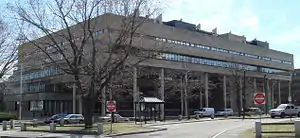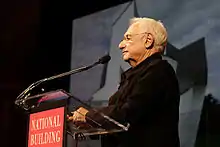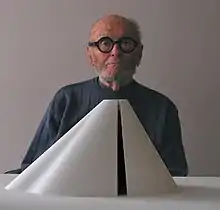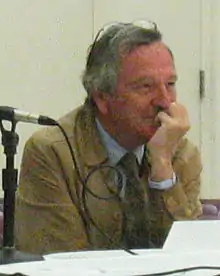Harvard Graduate School of Design
The Harvard Graduate School of Design (GSD) is a graduate school of design at Harvard University. Located in Cambridge, Massachusetts, the GSD offers master's and doctoral programs in architecture, landscape architecture, urban planning, urban design, real estate,[1] design engineering, and design studies.
 Coat of arms | |
| Type | Private |
|---|---|
| Established | 1874 (First courses taught) 1936 (GSD established) |
Parent institution | Harvard University |
| Dean | Sarah Whiting |
Academic staff | 206 |
| Students | 878 362 (Architecture) 161 (Urban Planning and Design) 182 (Landscape Architecture) 173 (Doctoral/Design Studies) |
| Location | , , United States |
| Campus | Urban |
| Website | gsd.harvard.edu |
The GSD has over 13,000 alumni and has graduated many famous architects, urban planners, and landscape architects. The school is considered a global academic leader in the design fields.[2][3]
The GSD has the world's oldest landscape architecture program (founded in 1893) and North America's oldest urban planning program (founded in 1900). Architecture was first taught at Harvard University in 1874.[4] The Graduate School of Design was officially established in 1936, combining the three fields of architecture, urban planning, and landscape architecture under one graduate school.[5]
History

Architecture
Charles Eliot Norton brought the first architecture classes to Harvard University in 1874.[6]
Urban planning
In 1900, the first urban planning courses were taught at Harvard University, and by 1909, urban planning courses taught by James Sturgis Pray were added into Harvard's design curriculum as part of the landscape architecture department. In 1923, a specialization in urban planning was established under the degree program of Master in Landscape Architecture. In 1929, North America's first urban planning degree (at graduate level) was established at Harvard under short-term funding from the Rockefeller Foundation. The degree program closed after MIT established a degree program in 1935. In 1980, the program was temporarily moved to the Harvard Kennedy School of Government until it returned to the GSD in 1984.
Landscape architecture
In 1893, the nation's first professional course in landscape architecture was offered at Harvard University. In 1900, the world's first landscape architecture program was established by Frederick Law Olmsted, Jr. and Arthur A. Shurcliff. The School of Landscape Architecture was established in 1913.[7]
Establishment
The three major design professions (architecture, urban planning, and landscape architecture) were officially united in 1936 to form the Harvard Graduate School of Design. In 1937, Walter Gropius joined the GSD faculty as chair of the Department of Architecture and brought modern designers, including Marcel Breuer to help revamp the curriculum.
In 1960, Josep Lluís Sert established the nation's first Urban Design program. George Gund Hall, which is the present iconic home GSD, opened in 1972 and was designed by Australian architect and GSD graduate John Andrews. The school's now defunct Laboratory for Computer Graphics and Spatial Analysis (LCGSA) is widely recognized as the research/development environment from which the now-commercialized technology of geographic information systems (GIS) emerged in the late 1960s and 1970s. More recent research initiatives include the Design Robotics Group, a unit that investigates new material systems and fabrication technologies in the context of architectural design and construction.[8][5]
Deans
| Dean | Tenure | Career |
|---|---|---|
| Joseph Hudnut | 1936–1953 | Architect |
| Josep Lluís Sert | 1953–1969 | Architect and urban planner |
| Maurice D. Kilbridge | 1969–1980 | Urban planner |
| Gerald M. McCue | 1980–1992 | Architect |
| Peter G. Rowe | 1992–2005 | Architect |
| Alan A. Altshuler | 2005–2008 | Urban planner |
| Mohsen Mostafavi | 2008–2019 | Architect |
| Sarah M. Whiting | 2019–present | Architect |
Academics

_-_DSC00068.JPG.webp)
The degrees granted in the masters programs include the Master of Architecture (MArch), Master in Landscape Architecture (MLA), Master of Architecture in Urban Design (MAUD), Master of Landscape Architecture in Urban Design (MLAUD), Master in Urban Planning (MUP), Master in Design Engineering (MDE), Master in Design Studies (MDes). The school also offers the Doctor of Design (DDes) and jointly administers a Doctor of Philosophy (PhD) degree in architecture, urban planning, and landscape architecture with the Graduate School of Arts and Sciences.[9]
- Master of Architecture (MArch)
- Master in Urban Planning (MUP)
- Master of Landscape Architecture (MLA)
- Master of Architecture in Urban Design (MAUD)
- Master in Design Engineering[10] (MDE)
- Master of Landscape Architecture in Urban Design (MLAUD)
- Master in Design Studies (MDes)[11]
- Doctor of Design (DDes)
- Doctor of Philosophy in Architecture, Urban Planning, and Landscape Architecture (PhD)[12]
Rankings
As of 2016, the program's ten-year average ranking places it 1st, overall, on DesignIntelligence's ranking of programs accredited by the National Architectural Accrediting Board.
Executive Education
Executive Education operates within GSD providing professional development classes.[13] The Advanced Management Development Program in Real Estate (AMDP) is a year-long executive development course open to established real estate professionals. Upon graduating from AMDP, participants are full-fledged Harvard University Alumni. Throughout the year, Executive Education offers short duration programs in the fields of architecture, urban planning, design, and real estate to a diverse audience of learners.[13]
Student body

As of 2012–2013, there were 878 students enrolled. 362 students or 42% were enrolled in architecture, 182 students or 21% in landscape architecture, 161 students or 18% in urban planning, and 173 students or 20% in doctoral or design studies programs. Approximately, 65% of students were Americans. The average student is 27 years old.[14] GSD students are represented by the Harvard Graduate Council (HGC), a university-wide student government organization. There are also several dozen internal GSD student clubs.[15]
Research and publications
In addition to its degree programs, the GSD administers the Loeb Fellowship, and numerous research initiatives such as the Zofnass Program for Sustainable Infrastructure. The school publishes the bi-annual Harvard Design Magazine, Platform, and other design books and studio works.
Design Research Labs
The GSD Design Labs synthesize theoretical and applied knowledge through research with the intent to enable design to be an agent of change in society. There are seven current labs: Material Processes and Systems Group; Energy, Environments and Design; New Geographies Lab; Responsive Environments and Artifacts Lab; Social Agency Lab; Urban Theory Lab; Geometry Lab.
Campus
The GSD campus is located northeast of Harvard Yard and across the street from Memorial Hall. Gund Hall is the main building of the GSD, and it houses most of the student space and faculty offices. Other nearby buildings include space for the school's Design Research Labs, faculty offices, the Loeb Fellowship program office, and research space for students, including those in the MDes and DDes programs.
Gund Hall
.jpg.webp)
Gund Hall is the main building, which has studio spaces and offices for approximately 800 students and more than 100 faculty and staff, lecture and seminar rooms, workshops and darkrooms, an audiovisual center, computer facilities, Chauhaus, the cafeteria, a project room, Piper Auditorium, and the Frances Loeb Library. The central studio space, also known as the Trays, extends through five levels under a stepped, clear-span roof. Gund Hall has a yard that comprises a basketball court and is often used for events, as an exhibition area for class projects, and as the setting for commencement ceremonies. The building was designed by architect John Andrews and supervised by structural engineer William LeMessurier both GSD alumni.[16]
Frances Loeb Library
The Frances Loeb Library, is the main library of the Graduate School of Design. The library has a collection of over 300,000 books and journals. It also has a Materials and Visual Resources Department, and the Special Collections Department, which houses the GSD's rare books and manuscript collection.
Fabrication Lab
The Fabrication Lab has both traditional tools and state-of-the-art technology available for model making and prototyping to faculty research and student course work. The Fabrication Lab has a full wood shop, metals shop, printing labs, 3D printing, CNC tools, robotic machines, laser cutter machines, etc.[17]
Notable alumni and faculty
As of 2013, the GSD had over 13,000 alumni in 96 countries. The GSD had 77 faculty members and 129 visiting faculty members. 45% of the faculty members were born outside of the United States.[18]




Alumni
- Alejandro Zaera-Polo
- Alexandra Lange, critic
- Andy Fillmore, urban designer and incumbent member of the Canadian parliament for Halifax
- Anita Berrizbeitia, landscape architect and Chair of the Department of Landscape Architecture, Harvard University GSD
- Bruno Zevi, architect, critic, and historian
- John Andrews, designer of the GSD's Gund Hall
- Charles Jencks, landscape architect and architectural theorist
- Christopher Alexander, architect, co-author of A Pattern Language
- Christopher Charles Benninger, architect
- Shaun Donovan (born 1966), former US Secretary of Housing and Urban Development and Director of the Office of Management and Budget, running for Mayor of New York City
- Cornelia Oberlander, landscape architect
- Dan Kiley, modernist landscape architect
- Danny Forster, architect and television host
- Edward Durell Stone, Modernist architect
- Edward Durell Stone, Jr., landscape architect, founder of EDSA
- Edward Larrabee Barnes, prolific Modernist architect
- Eliot Noyes
- Farshid Moussavi
- Frank Gehry, Pritzker Prize Laureate, awarded honorary doctorate, studied urban planning
- Fumihiko Maki, Pritzker Prize Laureate
- Garrett Eckbo, modernist landscape architect
- George Ranalli
- Grace La, architect
- Grant Jones, landscape architect
- Harry Seidler
- Henry N. Cobb
- Hideo Sasaki, landscape architect, former department chair, founder of Sasaki Associates and Sasaki Walker Associates
- Hugh Stubbins, architect
- Ian McHarg, landscape planner, GIS development
- IM Pei, Pritzker Prize Laureate
- Jack Dangermond, landscape architecture, GIS development, co-founder of Environmental Systems Research Institute (ESRI)
- Jeanne Gang
- John Hejduk
- Joshua Prince-Ramus
- Julian Wood Glass Jr., businessman, philanthropist
- Ken Smith (architect),landscape architect, educator
- Kongjian Yu, landscape architect, educator, founder of Turenscape, Peking
- Lawrence Halprin, landscape architect
- Mario Torroella, architect and artist, co-founder of HMFH Architects
- Meejin Yoon, architect and Dean of Cornell University College of Architecture, Art, & Planning
- Michael Graves
- Michael Maltzan, architect
- Michel Mossessian, architect, Design Principal and Founder of mossessian & partners
- Michele Michahelles, Paris-based architect, led restoration of Les Invalides
- Mikyoung Kim, landscape architect
- Mitchell Joachim
- Monica Ponce de Leon, dean and professor, Princeton University School of Architecture; principal, MPdL Studio
- Richard T. Murphy, Jr.
- Nader Tehrani (g. 1991)[19] – Dean, The Irwin S. Chanin School of Architecture of the Cooper Union, Founding Principal of NADAAA
- Paul Rudolph
- Philip Johnson, Pritzker Prize Laureate
- Preston Scott Cohen, architect
- Robert F. Fox, Jr.
- Robert Geddes, architect and Dean of Princeton School of Architecture
- Roger Montgomery, first HUD Urban Designer, dean at U.C. Berkeley
- Shaun Donovan, former Secretary of Housing and Urban Development
- Thom Mayne, Pritzker Prize Laureate
- William Curtis, architectural historian
- William LeMessurier, structural engineer founder of LeMessurier Consultants
- Yoshio Taniguchi
Current faculty
Notable faculty currently at the school include Anita Berrizbeitia, Jorge Silvetti, Antoine Picon, Farshid Moussavi, Jeanne Gang, John R. Stilgoe, K. Michael Hays, Krzysztof Wodiczko, Martha Schwartz, Mohsen Mostafavi, Preston Scott Cohen, Rahul Mehrotra, Rem Koolhaas, Grace La, Rafael Moneo, Sarah M. Whiting, Toshiko Mori, Mark Lee, and Sharon Johnston.
Emeritus faculty
Former faculty
- Barbara Bestor[20]
- Bjarke Ingels, Visiting Professor[21]
- Christopher Tunnard, landscape architect
- Eduard Sekler
- George Hargreaves, landscape architect
- Gerhard Kallmann, Kallmann & McKinnell, designer of Boston City Hall
- Henry N. Cobb, Pei Cobb Freed & Partners, designer of John Hancock Tower in Boston
- Hugh Stubbins, architect, designer of Citigroup Center
- J. B. Jackson, vernacular American landscape writer
- Jaqueline Tyrwhitt, 1955–1969
- Richard M. Sommer, 1998–2009
- Jerzy Sołtan, 1959-1979
- John Wilson (sculptor)
- Josep Lluis Sert, dean of the GSD from 1953 to 1969 and often credited with being instrumental in bringing modernist architecture to the United States
- Joshua Prince-Ramus, Visiting Professor
- Kenneth John Conant
- Marcel Breuer
- Martin Wagner, German architect and housing expert
- Michael McKinnell, Kallmann & McKinnell, designer of Boston City Hall
- Monica Ponce de Leon
- Moshe Safdie, designer of Habitat
- Peter Walker, landscape architect
- Rick Joy, Visiting Professor
- Serge Chermayeff, 1953–1962[22]
- Sigfried Giedion, author of the highly influential history Space, Time and Architecture
- Theodora Kimball Hubbard, librarian, 1911-1924
- Walter Gropius, 1937–1952; founder of Bauhaus
- Wilhelm von Moltke, 1964-1977
- Zaha Hadid, Pritzker Prize Laureate
References
- "About - REAL ESTATE and the BUILT ENVIRONMENT". REAL ESTATE and the BUILT ENVIRONMENT. Retrieved November 17, 2015.
- "The Best US Architecture Schools for 2014 are..." November 4, 2013.
- "2013 United States Best Architecture Schools". November 21, 2012.
- "Harvard Graduate School of Design". www.gsd.harvard.edu.
- "Archived copy" (PDF). Archived from the original (PDF) on August 10, 2013. Retrieved May 12, 2014.CS1 maint: archived copy as title (link)
- "Harvard University, Graduate School of Design. The GSD History Collection, Administrative Affairs: An Inventory". Retrieved November 22, 2017.
- Alofsin, Anthony (2002). The Struggle for Modernism: Architecture, Landscape Architecture, and City Planning at Harvard.
- . gsd.harvard.edu. Retrieved on 2012-04-03.
- "Doctoral Programs". Harvard Graduate School of Design. Harvard University. Retrieved October 23, 2013.
- "Harvard Master in Design Engineering". www.mde.harvard.edu. Retrieved March 5, 2020.
- "Harvard Graduate School of Design - Homepage". www.gsd.harvard.edu. Retrieved January 19, 2016.
- "Doctoral Programs". Harvard Graduate School of Design. Harvard University. Retrieved September 2, 2015.
- "Harvard Graduate School of Design Executive Education". Retrieved May 29, 2020.
- "Archived copy" (PDF). Archived from the original (PDF) on March 20, 2013. Retrieved May 12, 2014.CS1 maint: archived copy as title (link)
- Student Group Directory, Harvard Graduate School of Design, Retrieved 22 April 2018
- "Architectural Forum - December 1972" (PDF). Retrieved July 14, 2019.
- "Harvard Graduate School of Design". www.gsd.harvard.edu.
- "Endowment" (PDF). Archived from the original (PDF) on August 4, 2017. Retrieved November 22, 2017.
- "Harvard Graduate School of Design - Nader Tehrani". www.gsd.harvard.edu. Retrieved July 1, 2016.
- Emily Young, Building a Name for Herself, The Los Angeles Times, March 14, 2002
- "Judges 2009 Bjarke Ingels". World Architecture Festival. Archived from the original on February 26, 2012. Retrieved October 20, 2009.
- Alan Powers, "Chermayeff, Serge", Grove Art Online